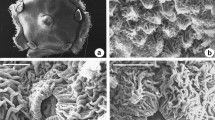Abstract
Lonicera maackii (Rupr.) Maxim. (Amur honeysuckle) is native to Asia and an important ornamental in China. However, the anatomy of leaf abscission (shedding) in L. maackii had not been studied previously. Such work is needed not only because knowledge of the leaf abscission process is important for a horticultural species like L. maackii but also because leaf abscission is probably the least understood abscission process, as it occurs so rapidly. Therefore, our objective was to use scanning electron microscopy (SEM) to examine the progression of leaf abscission in L. maackii at the cellular level. L. maackii branches with leaves were regularly collected in Beijing, China over the 2-month period in which leaves abscise, and examined with SEM. We found that, unlike in model species, the cortex is involved in abscission, forming an “abaxial gap.” We discovered that there is no discrete abscission zone prior to the onset of abscission and that no cell divisions precede abscission. An abscission zone did become evident well after the abscission process had begun, but its cells were enlarged, not constricted as in typical abscission zones. In the abaxial gap, intact cells separated at their middle lamella, but in the abscission zone, cell separation involved the entire wall, which is not typical. We did observe expected mechanical fission of vascular tissues. While the leaf abscission process we observed in L. maackii has similarities with model systems, aspects deviate from the expected.



Similar content being viewed by others
References
Addicott FT (1982) Abscission. University of California Press, London
Angiosperm Phylogeny Group (APG) II (2003) An update of the Angiosperm Phylogeny Group classification for the orders and families of flowering plants: APG II. Bot J Lin Soc 141:399–436
Facey V (1950) Abscission of leaves in Fraxinus americana L. New Phytol 49:103–116
Gawadi AG, Avery GS Jr (1950) Leaf abscission and the so-called “abscission layer”. Am J Bot 37:172–180
González-Carranza ZH, Lozoya-Gloria E, Roberts JA (1998) Recent developments in abscission: shedding light on the shedding process. Trends Plant Sci 3:10–14
Jensen WK (1962) Botanical histochemistry. WH Freeman, San Francisco
Leatherman AD (1955) Ecological life-history of Lonicera japonica Thunb. Dissertation, University of Tennessee
Mackenzie KAD (1979) The structure of the fruit of the red raspberry (Rubus idaeus L.) in relation to abscission. Ann Bot 43:355–362
Roberts JA, Shindler BC, Tucker GA (1984) Ethylene-promoted tomato flower abscission and the possible involvement of an inhibitor. Planta 160:159–163
Roberts JA, Whitelaw CA, González-Carranza ZH, McManus M (2000) Cell separation processes in plants—models, mechanisms and manipulation. Ann Bot 86:223–235
Schierenbeck KA, Marshall JD (1993) Seasonal and diurnal patterns of photosynthetic gas exchange for Lonicera sempervirens and L. japonica (Caprifoliaceae). Am J Bot 80:1292–1299
Sexton R (1976) Some ultrastructural observations on the nature of foliar abscission in Impatiens sultani. Planta 128:49–58
Sexton R, Redshaw AJ (1981) The role of cell expansion in the abscission of Impatiens sultani leaves. Ann Bot 48:745–756
van Nocker S (2009) Development of the abscission zone. Stewart Posthar Rev 1:1–6
Webster BD (1968) Anatomical aspects of abscission. Plant Physiol 43:1512–1544
Xu B-S, Wang H-J (1988) Caprifoliaceae. In: Xu B-S (ed) Fl Reipub Pop Sin Science Press, Beijing 72:12–104
Acknowledgments
This work was supported by the fund for state key disciplines and the Chinese Academy of Sciences Laboratory [grant number: O5S0671204 provided to HFW] and a National Sciences and Engineering Research Council of Canada Discovery Grant [grant number 164375 provided to CRF]. We are very grateful to Zhi-xin Zhu, Jie Li, and Jian-fei Ye for experimental assistance, and we sincerely thank Xiao-min Ma for help with referencing.
Conflict of interest
The authors declare that they have no conflict of interest.
Author information
Authors and Affiliations
Corresponding authors
Additional information
Corresponding authors:
C. Ross Friedman – English
J.-C. Shi – Chinese
An erratum to this article can be found at http://dx.doi.org/10.1007/s00709-010-0174-0
Rights and permissions
About this article
Cite this article
Wang, HF., Ross Friedman, C.M., Shi, JC. et al. Anatomy of leaf abscission in the Amur honeysuckle (Lonicera maackii, Caprifoliaceae): a scanning electron microscopy study. Protoplasma 247, 111–116 (2010). https://doi.org/10.1007/s00709-010-0159-z
Received:
Accepted:
Published:
Issue Date:
DOI: https://doi.org/10.1007/s00709-010-0159-z




